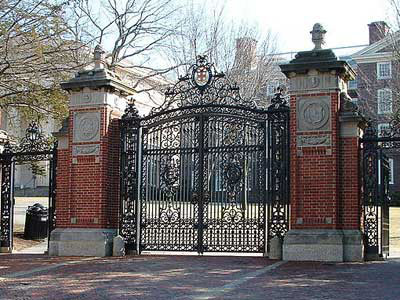
This year’s best 100 private universities disprove the notion that a great private-school education is unaffordable. In fact, the net average price -- the amount families pay after financial aid is applied -- is a relatively reasonable $22,000 a year, and some of the best institutions in the country, and on our list, offer a net price below $20,000.
Here are our top ten picks for best values in private universities. The slide show begins with the navigation bar to the right.
By Jane Bennett Clark

Princeton University
Location: Princeton, N.J.
Undergraduate Enrollment: 5,113
Admission Rate: 10%
SAT: 96% scored 600 or higher on verbal/98% scored 600 or higher on math
Student/Faculty Ratio: 6
Graduation Rate 4-yr./5-yr.: 90%/95%
Total Cost: $49,780
Total Cost After Average Financial Aid: $14,754
Average Debt at Graduation: $4,957
The first university to eliminate loans from its financial aid package, Princeton gets its graduates out the door with the lowest average debt of any institution in our rankings. It is the only Ivy League school with a sticker price that falls below $50,000.

Yale University
Location: New Haven, Conn.
Undergraduate Enrollment: 5,275
Admission Rate: 8%
SAT (V/M) or ACT: 97%/98%
Student/Faculty Ratio: 6
Graduation Rate 4-yr./5-yr.: 90%/97%
Total Cost: $50,800
Total Cost After Average Financial Aid: $11,530
Average Debt at Graduation: $10,717
Yale’s average need-based financial aid is the most generous among our 50 top-ranked universities. Its generous financial aid policy cuts the average cost of attendance by half and excludes loans from the equation.

California Institute of Technology
Location: Pasadena, Cal.
Undergraduate Enrollment: 951
Admission Rate: 15%
SAT (V/M) or ACT: 98%/100%
Student/Faculty Ratio: 3
Graduation Rate 4-yr./5-yr.: 81%/87%
Total Cost: $49,002
Total Cost After Average Financial Aid: $15,100
Average Debt at Graduation: $8,218
Set in picturesque Pasadena, Caltech boasts brainy students (almost all the incoming freshmen score more than 600 on their SATs) and the lowest student-to-faculty ratio on both our lists. Its financial aid keeps the average student debt low.

Rice University
Location: Houston, Tex.
Undergraduate Enrollment: 3,319
Admission Rate: 22%
SAT (V/M) or ACT: 88%/93%
Student/Faculty Ratio: 5
Graduation Rate 4-yr./5-yr.: 83%/92%
Total Cost: $46,321
Total Cost After Average Financial Aid: $21,340
Average Debt at Graduation: $16,716
With the lowest sticker price of our top-25-ranked universities, along with generous need-based and merit-based aid, Rice lives up to its reputation for affordability. It boasts a student-to-faculty ratio of five to one, second only to Caltech.

Duke University
Location: Durham, N.C.
Undergraduate Enrollment: 6,578
Admission Rate: 19%
SAT (V/M) or ACT: 92%/95%
Student/Faculty Ratio: 8
Graduation Rate 4-yr./5-yr.: 83%/92%
Total Cost: $53,157
Total Cost After Average Financial Aid: $16,581
Average Debt at Graduation: $23,059
Duke meets the full need of all students, provides a strong need-based aid award and offers substantial merit scholarships. Its Durham location is part of the renowned Research Triangle.

Harvard University
Cambridge, Mass.
Undergraduate Enrollment: 6,655
Admission Rate: 7%
SAT (V/M) or ACT: 100%/100%
Student/Faculty Ratio: 7
Graduation Rate 4-yr./5-yr.: 89%/96%
Total Cost: $53,227
Total Cost After Average Financial Aid: $12,993
Average Debt at Graduation: $10,871
The most competitive institution on both our lists, Harvard draws top students: 100% of incoming freshmen score 600 or higher on their math and verbal SATs. Harvard’s average need-based aid package is second-highest among our top 50 universities.

University of Pennsylvania
Location: Philadelphia, Pa.
Undergraduate Enrollment: 9,768
Admission Rate: 18%
SAT (V/M) or ACT: 94%/98%
Student/Faculty Ratio: 6
Graduation Rate 4-yr./5-yr.: 88%/94%
Total Cost: $53,064
Total Cost After Average Financial Aid: $20,004
Average Debt at Graduation: $17,787
An Ivy League institution with an urban campus, U-Penn. offers need-based financial aid to families earning as much as $190,000. Like most of its elite counterparts, Penn has replaced loans with grants in its financial aid awards.

Columbia University
Location: New York, N.Y.
Undergraduate Enrollment: 5,766
Admission Rate: 10%
SAT (V/M) or ACT: 97%/98%
Student/Faculty Ratio: 6
Graduation Rate 4-yr./5-yr.: 88%/94%
Total Cost: $57,192
Total Cost After Average Financial Aid: $19,702
Average Debt at Graduation: $11,564
One of the country’s oldest institutions of higher education, this highly selective university offers a low student-to-faculty ratio and enables students to graduate with a low average debt.

Brown University
Admission Rate: 11%
SAT (V/M) or ACT: 90%/93%
Student/Faculty Ratio: 9
Graduation Rate 4-yr./5-yr.: 86%/94%
Total Cost: $52,670
Total Cost After Average Financial Aid: $18,084
Average Debt at Graduation: $21,858
Brown offers substantial merit scholarships to a few students, but most of its financial aid resources go to funding generous need-based aid. Students here design their own fields of study.

Dartmouth University
Location: Hanover, N.H.
Undergraduate Enrollment: 4,196
Admission Rate: 13%
SAT (V/M) or ACT: 93%/93%
Student/Faculty Ratio: 8
Graduation Rate 4-yr./5-yr.: 85%/93%
Total Cost: $54,175
Total Cost After Average Financial Aid: $15,726
Average Debt at Graduation: $19,081
The smallest of the Ivies, Dartmouth combines a glorious mountain-view setting with top academics and a strong need-based aid package. Two-thirds of Dartmouth’s students study abroad.

More From Kiplinger
SLIDE SHOW: Top 10 Liberal Arts Colleges
SPECIAL REPORT: Best College Values
TOOL: See Our Complete Rankings
QUIZ: Test Your Knowledge of Financial Aid
SPECIAL REPORT: Paying for College
Profit and prosper with the best of Kiplinger's advice on investing, taxes, retirement, personal finance and much more. Delivered daily. Enter your email in the box and click Sign Me Up.
-
 Is Mechanical Breakdown Insurance Better Than an Extended Car Warranty?
Is Mechanical Breakdown Insurance Better Than an Extended Car Warranty?More insurers are starting to offer mechanical breakdown insurance to new car owners. What is it and should you buy it?
-
 What to Do When You Bank Lowers Your APY
What to Do When You Bank Lowers Your APYWhy banks lower APYs, options you can explore when it happens and whether more rate cuts are on the horizon.
-
 Forget Financial Forecasts: Focus on These 3 Goals for Success
Forget Financial Forecasts: Focus on These 3 Goals for SuccessWe know the economy is unpredictable and markets will do what they do, no matter who predicts what. Here's how to focus on what you can control.
-
 What to Do With Your Tax Refund: 6 Ways to Bring Growth
What to Do With Your Tax Refund: 6 Ways to Bring GrowthUse your 2024 tax refund to boost short-term or long-term financial goals by putting it in one of these six places.
-
 What Does Medicare Not Cover? Eight Things You Should Know
What Does Medicare Not Cover? Eight Things You Should KnowMedicare Part A and Part B leave gaps in your healthcare coverage. But Medicare Advantage has problems, too.
-
 15 Reasons You'll Regret an RV in Retirement
15 Reasons You'll Regret an RV in RetirementMaking Your Money Last Here's why you might regret an RV in retirement. RV-savvy retirees talk about the downsides of spending retirement in a motorhome, travel trailer, fifth wheel, or other recreational vehicle.
-
 The Six Best Places to Retire in New England
The Six Best Places to Retire in New Englandplaces to live Thinking about a move to New England for retirement? Here are the best places to land for quality of life, affordability and other criteria.
-
 The 10 Cheapest Countries to Visit
The 10 Cheapest Countries to VisitWe find the 10 cheapest countries to visit around the world. Forget inflation and set your sights on your next vacation.
-
 15 Ways to Prepare Your Home for Winter
15 Ways to Prepare Your Home for Winterhome There are many ways to prepare your home for winter, which will help keep you safe and warm and save on housing and utility costs.
-
 Six Steps to Get Lower Car Insurance Rates
Six Steps to Get Lower Car Insurance Ratesinsurance Shopping around for auto insurance may not be your idea of fun, but comparing prices for a new policy every few years — or even more often — can pay off big.
-
 How to Increase Credit Scores — Fast
How to Increase Credit Scores — FastHow to increase credit scores quickly, starting with paying down your credit card debt.
